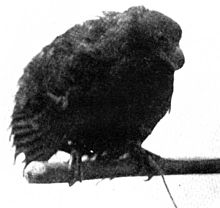Didunculus
| Tooth-billed pigeons | |
|---|---|

| |
| Live specimen of Didunculus strigirostris in 1901 | |
| Scientific classification | |
| Domain: | Eukaryota |
| Kingdom: | Animalia |
| Phylum: | Chordata |
| Class: | Aves |
| Order: | Columbiformes |
| Family: | Columbidae |
| Genus: | Didunculus Peale, 1848 |
| Species | |
|
Two species, see article | |
The tooth-billed pigeons are the only genus (Didunculus) of the subfamily Didunculinae, in the pigeon and dove family, (Columbidae). It has no close living relatives, but it has been shown to be genetically close to the dodo,[1] and the genus name Didunculus means "little dodo".[2] The jaw and tongue structure, and the superficially parrotlike bill have suggested a relationship to the parrots, but these features have arisen from its specialised diet rather than any real relationship.
Species
Two species are known:
- †Didunculus placopedetes, Tongan tooth-billed pigeon (EX)
- Didunculus strigirostris, Tooth-billed pigeon (CR)
The Tongan tooth-billed pigeon (Didunculus placopedetes) is only known from subfossil[3] remains in several archaeological sites in Tonga dating 2700–2850 BP[4] and now extinct. The tooth-billed pigeon (Didunculus strigirostris) from Samoa is critically endangered.[5]
References
- ^ Shapiro, B.; Sibthorpe, D.; Rambaut, A.; Austin, J.; Wragg, G. M.; Bininda-Emonds, O. R. P.; Lee, P. L. M.; Cooper, A. (2002). "Flight of the Dodo" (PDF). Science. 295 (5560): 1683. doi:10.1126/science.295.5560.1683. PMID 11872833. Supplementary information
- ^ Rauzon, Mark J. (2007). "Island restoration: Exploring the past, anticipating the future" (PDF). Marine Ornithology. 35 (2): 97–107.
- ^ Hume, J.P.; Walters, M. (2012). Extinct Birds. London: T & AD Poyser. p. 544. ISBN 978-1-4081-5725-1.
- ^ Tyrberg, T. (2009). "Holocene avian extinctions". In Turvey, S.T. (ed.). Holocene extinctions. Oxford, UK: Oxford University Press. p. 352. ISBN 978-0-19-953509-5.
- ^
BirdLife International (2015). "Didunculus strigirostris". IUCN Red List of Threatened Species. 2015.
{{cite journal}}: Invalid|ref=harv(help)
